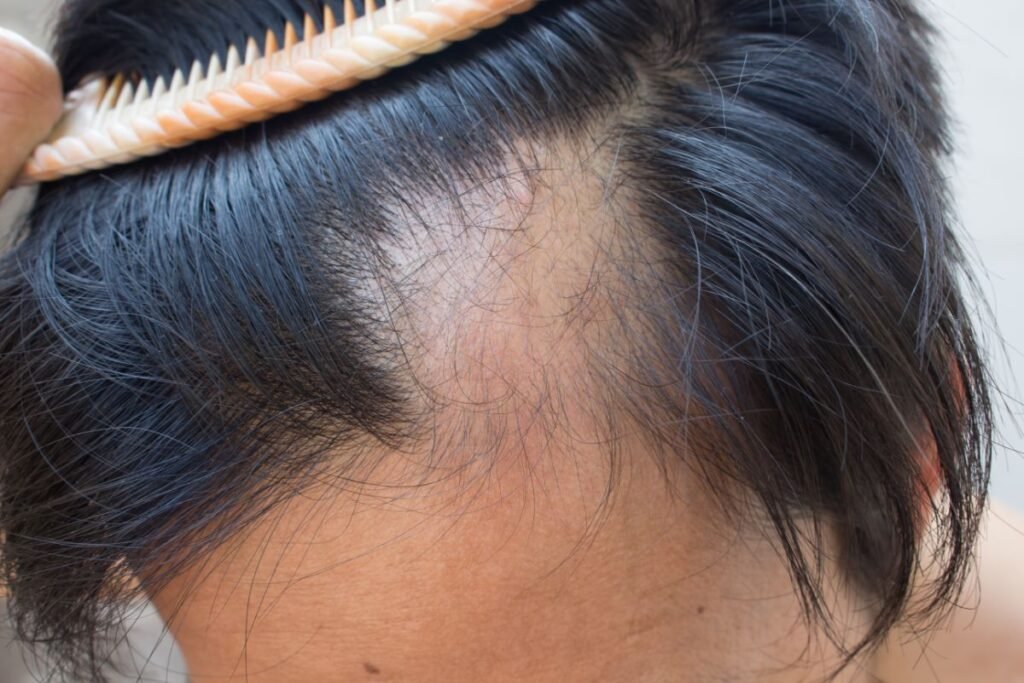Platelet-Rich Plasma (PRP) therapy is becoming one of the most sought-after treatments for hair loss. It’s natural, minimally invasive, and shows promising results for both men and women. However, the causes and patterns of hair loss differ significantly between the sexes—which means the way PRP works and is applied can also vary.
In this article, we’ll explore how PRP therapy addresses male vs. female pattern baldness, what outcomes you can expect, and how treatment protocols may differ.
Understanding Pattern Baldness in Men vs. Women
Before diving into PRP, it’s important to understand how male pattern baldness (MPB) and female pattern baldness (FPB) differ:
🔹 Male Pattern Baldness (Androgenetic Alopecia in Men):
- Typically starts with a receding hairline and thinning at the crown
- Follows a distinct pattern, often leading to partial or complete baldness
- Strongly linked to genetics and sensitivity to DHT (dihydrotestosterone)
- Often begins as early as late teens or early 20s
🔹 Female Pattern Baldness (Androgenetic Alopecia in Women):
- Usually presents as overall thinning, especially on the crown or part line
- Hairline typically remains intact
- Less related to DHT and more influenced by hormonal changes, stress, and age
- Common after menopause or during hormonal shifts (e.g., postpartum)
How PRP Works for Both Men and Women
PRP therapy involves injecting concentrated platelets from your own blood into the scalp. These platelets release growth factors that:
- Stimulate dormant or weakened hair follicles
- Improve blood flow to the scalp
- Increase hair shaft diameter
- Extend the hair growth (anagen) phase
While the mechanism of PRP is the same for both genders, how it is applied and how it responds can vary depending on the pattern of hair loss and underlying causes.
Key Differences in PRP Treatment for Men vs. Women
| Aspect | Male Pattern Baldness | Female Pattern Baldness |
|---|---|---|
| Pattern of Hair Loss | Receding hairline, bald spots, thinning crown | Diffuse thinning, especially at the crown or part line |
| Targeted Areas | Specific areas like temples and vertex | Wider, more generalized application across the scalp |
| Response to Treatment | Typically noticeable in crown/thinning zones | Slower but steadier response due to diffuse thinning |
| Underlying Cause | Genetic + DHT sensitivity | Hormonal changes, stress, aging, and genetics |
| Expectations | Hair regrowth and thickening in early-to-moderate stages | Improved density and slower progression of hair loss |
| Adjunct Therapies | Finasteride, Minoxidil, hair transplant | Hormonal therapy, Minoxidil, nutritional support |
PRP for Male Pattern Baldness
Benefits:
- Particularly effective in the early to moderate stages
- Helps preserve existing hair, delay further loss
- Can complement hair transplants by improving graft survival
- Improves scalp circulation and follicular activity
Limitations:
- Not effective on completely bald areas where follicles are inactive
- May require combination with DHT-blockers (e.g., finasteride) for best results
Treatment Strategy:
- Focused injections in thinning zones (crown, temples)
- Initial protocol: 3–4 sessions spaced 4–6 weeks apart, with maintenance every 4–6 months
PRP for Female Pattern Baldness
Benefits:
- Ideal for diffuse thinning and widening part lines
- Strengthens existing hair and encourages thicker regrowth
- Especially effective in women who are not candidates for surgery
- Helps reverse miniaturization of follicles
Limitations:
- Results may be slower and more subtle due to diffuse loss
- Hormonal imbalances (e.g., thyroid, PCOS, menopause) may need to be addressed for full benefit
Treatment Strategy:
- More widespread scalp injections
- Often combined with nutritional support, low-level laser therapy, or topical minoxidil
- Maintenance sessions are essential for sustained results
What to Expect: Before and After
Both men and women typically begin to see improvements in:
- Hair texture and shine (1–2 months)
- Reduced shedding (2–3 months)
- New hair growth and density (4–6 months)
- Full results (up to 12 months)
⚠️ Note: Individual results vary based on genetics, health, age, and consistency of treatment.
Who Makes a Good Candidate?
✅ Ideal Male Candidates:
- Early to moderate male pattern hair loss
- Still have active follicles in thinning areas
- Not ready for or seeking to avoid surgery
✅ Ideal Female Candidates:
- Thinning on the crown or widening part line
- Hormonal causes of hair loss (with medical support)
- In early to moderate stages of diffuse hair loss
Final Thoughts
PRP therapy is a safe, natural, and increasingly popular solution for both men and women experiencing hair loss. While the root causes and visible patterns of baldness differ between genders, PRP offers versatile, customizable treatment options that can restore thickness, boost follicle activity, and prevent further loss.
If you’re starting to notice thinning or excessive shedding, early intervention is key. Book a consultation with a hair restoration specialist to determine whether PRP is the right approach for your unique hair loss pattern—male or female.




